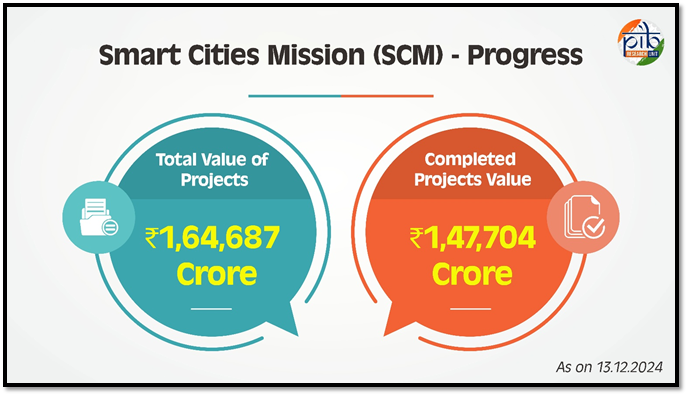Ministry of Housing & Urban Affairs
Smart Cities Mission Achievements
91% of Projects Completed, ₹1.47 Lakh Crore Invested
प्रविष्टि तिथि:
18 DEC 2024 5:35PM by PIB Delhi
“Hundreds of small cities have a key role in achieving the resolve of a developed India by 2047. Our government is upgrading basic facilities in such urban centres to improve ease of living.”
~Prime Minister Shri Narendra Modi[1]
Introduction
The Smart Cities Mission (SCM) aims to enhance the quality of life in India's cities through smart, sustainable solutions. Its goal is to create cities that are economically vibrant, inclusive and environment friendly. By focusing on key areas like infrastructure, governance and social development, SCM seeks to transform urban living across the country. With 100 cities leading the initiative, the mission has made significant progress, having completed 7,380 out of 8,075 projects, with an investment of ₹1,47,704 crore. These completed projects demonstrate SCM’s commitment to creating smarter, more livable urban spaces for all.

Smart Cities Mission in a Glance

Launched on 25 June 2015 by Prime Minister Shri Narendra Modi, the Smart Cities Mission aims to improve the quality of life in 100 cities by providing efficient services, robust infrastructure, and sustainable solutions. Focused on economic growth, inclusivity, and sustainability, it addresses diverse needs such as housing, transport, education, healthcare, and recreation, with the goal of creating adaptable urban spaces that serve as models for other cities.
Approach of this Mission
Implementing the Smart City Mission is carried out primarily through two approaches. First, under the Smart Cities Mission, cities are being developed using an Area-Based Development (ABD) approach, where each of the 100 cities has selected a defined area for targeted interventions. These ABD areas, chosen through citizen participation, are being developed as replicable models for other parts of the city.
Second, every city has included Pan-City Projects, which are technology-driven solutions. Other key dimensions of the mission include creating a Special Purpose Vehicle (SPV) structure for program implementation, promoting multiple sources of funding for projects, fostering competitive federalism, and engaging citizens.

Key Achievements of the Mission [2]
As of 13th December 2024, 91% of the total projects have been successfully completed, reflecting significant progress in reshaping urban landscapes across India.

Below are some key initiatives and milestones achieved by SCM (As on 15.11.24):
Integrated Command and Control Centres (ICCC): All 100 Smart Cities have operational ICCCs, which utilize data for making informed decisions. These ICCCs functioned as COVID war rooms during the pandemic and have significantly improved city operations such as transport, water supply, and solid waste management by integrating emerging technologies like AI, IoT, and Data Analytics.
Public Safety and Security: Over 84,000 CCTV surveillance cameras have been installed in 100 Smart Cities, aiding in crime monitoring. Additionally, 1,884 emergency call boxes, 3,000 public address systems, and traffic enforcement systems for red light violations and automatic number plate recognition have been installed, enhancing public safety.
Water Supply: More than 17,026 kilometers of the water supply system are being monitored through SCADA, reducing non-revenue water and leakages.
Solid Waste Management: Over 66 cities are managing solid waste with increased technology use, improving route management, efficiency of collection, and daily management. Around 9,194 vehicles have been RFID-enabled for Automatic Vehicle Location (AVL) to digitize and improve solid waste management efficiency.
Mobility: Over 1,740 kilometers of smart roads have been constructed or improved, and 713 kilometers of cycle tracks have been developed. Furthermore, an Intelligent Transport Management System (ITMS) has been implemented and is being monitored through ICCCs, improving traffic operations, enforcing traffic violations, and reducing journey time.
Education: 9,433 smart classrooms and 41 digital libraries have been developed.
Health: 172 e-health centers and clinics (without dedicated beds) have been developed, and 152 health ATMs also have been installed.
Adapting to Emerging Needs and Overcoming Challenges
In addition to the core initiatives, the Smart Cities Mission has introduced projects in response to emerging challenges. For example, in the wake of the COVID-19 pandemic, campaigns like ‘Cycles4Change’ and ‘Streets4People’ were launched to promote open spaces for active living. To ensure inclusive access to public spaces, initiatives such as the ‘Placemaking Marathons’ and ‘Nurturing Neighbourhoods Challenge’ focused on vulnerable groups. Other challenges, like ‘Transport4All’ and ‘EatSmart Cities’ aim to support public transport startups and improve food hygiene in smart cities.
Strategies for Smart City Mission
The Smart Cities Mission seeks to boost economic growth and enhance the quality of life by promoting local area development and utilizing technology for smart outcomes. The approach involves transforming existing areas through retrofitting and redevelopment, developing new areas through greenfield projects, and implementing smart solutions across the city with Pan-city initiatives. Each city's proposal must include one of the area-based models (retrofitting, redevelopment, or greenfield development) along with a Pan-city feature to ensure inclusivity and benefits for all residents. In North Eastern and Himalayan states, the development area requirements are reduced by half.




Conclusion
The Smart Cities Mission has made great progress in improving cities across India. Through smart technology, sustainable solutions, and active community involvement, the mission has enhanced infrastructure, public safety, mobility, water supply, and healthcare. Additionally, it has adapted to new challenges, like promoting open spaces and safer transport, through initiatives such as ‘Cycles4Change’ and ‘Streets4People.’ As the mission moves forward, it continues to work towards building smarter, more livable cities that can serve as examples for others to follow.
References
Click here to see PDF.
******
Santosh Kumar/ Sarla Meena/ Kamna Lakaria
(रिलीज़ आईडी: 2085711)
आगंतुक पटल : 6215